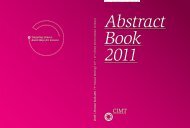Abstract Book 2010 - CIMT Annual Meeting
Abstract Book 2010 - CIMT Annual Meeting
Abstract Book 2010 - CIMT Annual Meeting
Create successful ePaper yourself
Turn your PDF publications into a flip-book with our unique Google optimized e-Paper software.
040 Kotsiou | Cellular therapy<br />
Application of MHC class I single chain trimers for leukaemia<br />
immunotherapy<br />
Eleni Kotsiou 1,2 , Julian Dyson 2 , Keith G Gould 1<br />
1<br />
Department of Immunology, Wright-Fleming Institute, St Mary’s campus, Imperial College,<br />
London W2 1PG, UK<br />
2<br />
Immunobiology Section, Commonwealth Building, Hammersmith Hospital, Imperial College,<br />
London W12 ONN, UK<br />
84<br />
Major Histocompatibility Complex (MHC) class I<br />
single chain trimers (SCTs) consist of antigenic<br />
peptide, β2-microglobulin and MHC heavy chain<br />
all joined together in a single polypeptide molecule<br />
via flexible linkers. SCTs are extremely valuable<br />
tools for the stimulation of CD8+ T cell responses<br />
because of their enhanced stability compared to<br />
conventional MHC molecules and can therefore be<br />
used for the expansion of peptide specific CD8+ T<br />
cells either in vitro or in vivo.<br />
We have expressed the human minor histocompatibility<br />
(H) antigens, HA-1 and HA-2 (expressed only<br />
on haematopoietic cells and restricted by human<br />
leukocyte antigen (HLA) A2) and the mouse HY<br />
minor transplantation antigens originating from<br />
the Smcy and Uty genes (restricted by H2-Db) in the<br />
SCT format. For the HLA-A2 SCTs, different forms<br />
were constructed by modifying the CD8 binding<br />
region (CD8 enhanced and non-binding variants)<br />
whereas in both mouse and human SCTs we introduced<br />
cysteine residues in the heavy chain and<br />
first linker that have been shown to form a disulfide<br />
bond, anchoring the peptide more efficiently<br />
(disulfide-trap (dt) variants).<br />
All human and mouse SCTs had good cell surface<br />
expression as determined by specific antibody<br />
staining of TAP2- deficient CHO cell transfectants.<br />
Soluble forms of HA-1 and HA-2 SCTs were obtained<br />
by retroviral transduction of human embryonic<br />
kidney (HEK) 293 T cells, and subsequent purification<br />
of the soluble protein from culture superna-<br />
tant. As the HA-1 and HA-2 minor H antigens are<br />
only expressed on normal and malignant haematopoietic<br />
cells, they are good candidates for therapeutic<br />
targeting. For this reason soluble SCTs were<br />
used for the in vitro expansion of allo-restricted<br />
CD8+ T cells specific for HA-1 and HA-2 minor H<br />
antigens from HLA-A2 negative individuals. Furthermore<br />
the minor male specific transplantation<br />
antigens DbUty and DbSmcy were expressed as<br />
SCTs and dtSCTs and will be introduced into bone<br />
marrow dendritic cells by retroviral transduction.<br />
Their potential to expand antigen specific CD8+<br />
T cells in vitro and in vivo as a vaccination model<br />
will be assessed. Further results will be presented<br />
illustrating the applications and functions of MHC<br />
class I SCTs.



